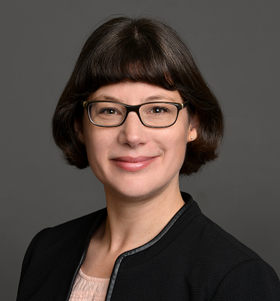

Research Interests
-
History of the English language
-
Old and Middle English
-
Historical lexicology and semantics
-
Medieval glosses and glossaries, the history of linguistic thought
-
Writing systems, runes, the Roman alphabet
-
Orality and literacy in the Middle Ages
-
Historical multilingualism
Short Bio
Annina Seiler joined the English Seminar of the University of Zurich as Wissenschaftliche Mitarbeiterin in 2009. She teaches English historical linguistics at the BA and MA level as well as modern and historical linguistics for students of the Pädagogische Hochschule Zürich. Annina holds a PhD in English Linguistics and an MA in German Linguistics and Literature, English Linguistics, and Comparative Germanic Philology from the University of Zurich.
In her doctoral dissertation, Annina investigated how Old English and Old High German were first put into writing. Her research shows that, contrary to expectations, early medieval writing systems were highly regular. Her favourite letter of the alphabet is the double-U: in a graphemic love-story of sorts, two U’s were joined together to create this new letter. In her postdoctoral research project, Annina has studied glossaries and dictionaries from the early Anglo-Saxon period to the end of the Middle Ages and beyond. With two colleagues, she has published the handbook Medieval Glossaries from North-Western Europe: Tradition and Innovation (Brepols, 2023). Glossaries are important linguistic and cultural sources, and they are also fun to study. If you don’t believe it, check out her article on the unicorn!
Recent Activities
Annina is co-editor of the book Old English in Switzerland: Manuscripts, Texts and Libraries (Schwabe Verlag, forthcoming), which is one of the outcomes of a project undertaken in 2022 with MA students from the University of Zurich.
Currently, she is engaged in two collaborative research projects: Waxing and Waning Words: Lexical Variation and Change in Middle English (University of Zurich; Olga Timofeeva, Annina Seiler, Johanna Vogelsanger and Rihab Ayed) and An English Teacher in Paris: John of Garland’s Dictionarius and Medieval Language Learning (University of Westminster; Heather Pagan, Annina Seiler, Christine Wallis).
Teaching (Sample)
| “History of the English Language” | Regularly |
| “Old English Runes” | MA seminar, AS 2024 |
| “Grapholinguistics” | BA seminar, SS 2024 |
| “Old English in Switzerland” | MA project, SS/AS 2022 |
| “Names and Naming in the History of English” | BA seminar, SS 2021 |
| “Historical Code-Switching” | MA seminar, SS 2000 |
| “Word-Formation in English: A Diachronic Approach” | MA seminar, SS 2019 |
Supervision (Sample)
I am happy to supervise BA and MA theses on a range of topics including Old and Middle English language and literature, historical lexicology and lexicography, semantics, grapholinguistics, morphology, onomastics, historical pragmatics.
|
Links
Consultation hours: please sign up online
List of publications:
ZORA Publication List
Download Options
Publications
-
Birds, birds, birds: The dissemination and transformation of Old English Leviticus glosses on the Continent. In: Bulitta, Brigitte; Pelle, Stephen. Wörter – Texte – Schreiberhände: Sprachliche und kulturelle Wechselbeziehungen zwischen Fränkischem Reich, Irland und Britannien im Frühmittelalter. Leipzig: De Gruyter Akademie Forschung, 281-317.
-
Let Each One Tell its Own Story: Language Mixing in Four Copies of Amore Langueo. In: Pons-Sanz, Sara M; Sylvester, Louise. Medieval English in a Multilingual Context : Current Methodologies and Approaches. Cham: Palgrave Macmillan, 467-497.
-
Philological Approaches. In: Condorelli, Marco; Rutkowska, Hanna. The Cambridge Handbook of Historical Orthography. Cambridge: Cambridge University Press, 338-359.
-
Translating Middle English (Im)politeness: The Case of Geoffrey Chaucer’s Miller’s Tale. The Chaucer Review, 58(1):35-59.
-
Linguistic Layers in John of Garland’s Dictionarius. Études médiévales anglaises, 102(1):63-108.
-
Animal Glossaries (English and German traditions). In: Seiler, Annina; Benati, Chiara; Pons-Sanz, Sara M. Medieval Glossaries from North-Western Europe: Tradition and Innovation. Turnhout: Brepols Publishers, 449-472.
-
Introduction. In: Seiler, Annina; Benati, Chiara; Pons-Sanz, Sara M. Medieval Glossaries from North-Western Europe: Tradition and Innovation. Turnhout: Brepols Publishers, 23-49.
-
Turegum: Zurich, Constantia: Chostinza: Das Ortsnamenglossar in Zürich, Zentralbibliothek, Ms. Car. C 164. In: Marti Heinzle, Mirjam; Thöny, Luzius. Swe gameliþ ist: Studien zur vergleichenden germanischen Sprachwissenschaft: Festschrift für Ludwig Rübekeil zum 65. Geburtstag. Heidelberg: Universitätsverlag Winter, 177-194.
-
Multilingualism in medieval English glossaries: A multimodal analysis. In: Włodarczyk, Matylda; Tyrkkö, Jukka; Adamczyk, Elżbieta. Multilingualism from Manuscript to 3D: Intersections of Modalities from Medieval to Modern Times. New York: Routledge, 35-57.
-
Germanic names, vernacular sounds, and Latin spellings in early Anglo-Saxon and Alemannic charters. In: Gallagher, Robert; Roberts, Edward; Tinti, Francesca. The Languages of Early Medieval Charters : Latin, Germanic Vernaculars, and the Written Word. Leiden: Brill, 117-153.
-
Multilingual annotations in Ælfric’s Glossary in London, British Library, Cotton Faustina A. x: A commented edition. Early Middle English, 1(2):13-64.
-
The spelling of the Erfurt glossary. In: Nievergelt, Andreas; Rübekeil, Ludwig. 'athe in palice, athe in anderu sumeuuelicheru stedi'. Raum und Sprache: Festschrift für Elvira Glaser zum 65. Geburtstag. Heidelberg: Universit�tsverlag Winter, 525-540.
-
Teaching the history of the English language backwards. In: Moore, Colette; Palmer, Chris C. Teaching the History of the English Language. New York: Modern Language Association, 137-146.
-
Ælfric’s Glossary in the Middle English Period. In: Stenroos, Merja; Mäkinen, Martti; Thengs, Kjetil V; Traxel, Oliver M. Current Explorations in Middle English: Selected papers from the 10th International Conference on Middle English (ICOME), University of Stavanger, Norway, 2017. Bern: Peter Lang, 285-307.